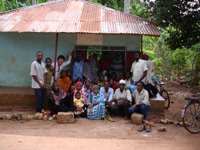On 1st of July, students had great time getting to know in deep their motherland history of stonetown...
Mr. farid the historian lead the students for a stonetown tour which started at 09.30 am. They were shown the carving doors of Zanzibar and historical houses of Zanzibar. After that, the students had a break for half an hour and we went to have the famous Swahili food called mbatata za urojo. This is made from potato and curry, cooked with flour.
Most of zanzibaris and even visitors who have roots in Zanzibar love this stuff, which was originally made by Indians a long time ago.
Zanzibar has lured traders, adventurers, plunderers and explorers to its shores for centuries. The Assyrians, Sumerians, Egyptians, Phoenicians, Indians, Chinese, Persians, Portuguese, Omani Arabs, Dutch and English have all been here at one time or another. Some, particularly the Shirazi Persians and Omani Arabs, stayed to settle and rule. With this influence, Zanzibar has become predominantly Islamic (97%) - the remaining 3% is made up of Christians, Hindus and Sikhs.
The earliest visitors to Zanzibar were Arab traders who are said to have arrived in the 8th century. The earliest building that remains on Zanzibar is the mosque at Kizimkazi, which dates from 1107, and is a present-day tourist attraction.Goods from Britain docked here before they moved on to other parts of Africa.
No longer very prosperous in the fiscal sense, the island has a wealth of historical monuments to visit which commemorate the African, British and particularly Arab influences- sultan's palaces, cathedrals, mosques, fortresses and old colonial houses. "Spice Tours" are the ideal way to see the island's historic sites and spice plantations.
Karibu Zanzibar!
Tuesday, July 15, 2008
A tour of Stone Town with Historian Farid
Subscribe to:
Post Comments (Atom)





No comments:
Post a Comment